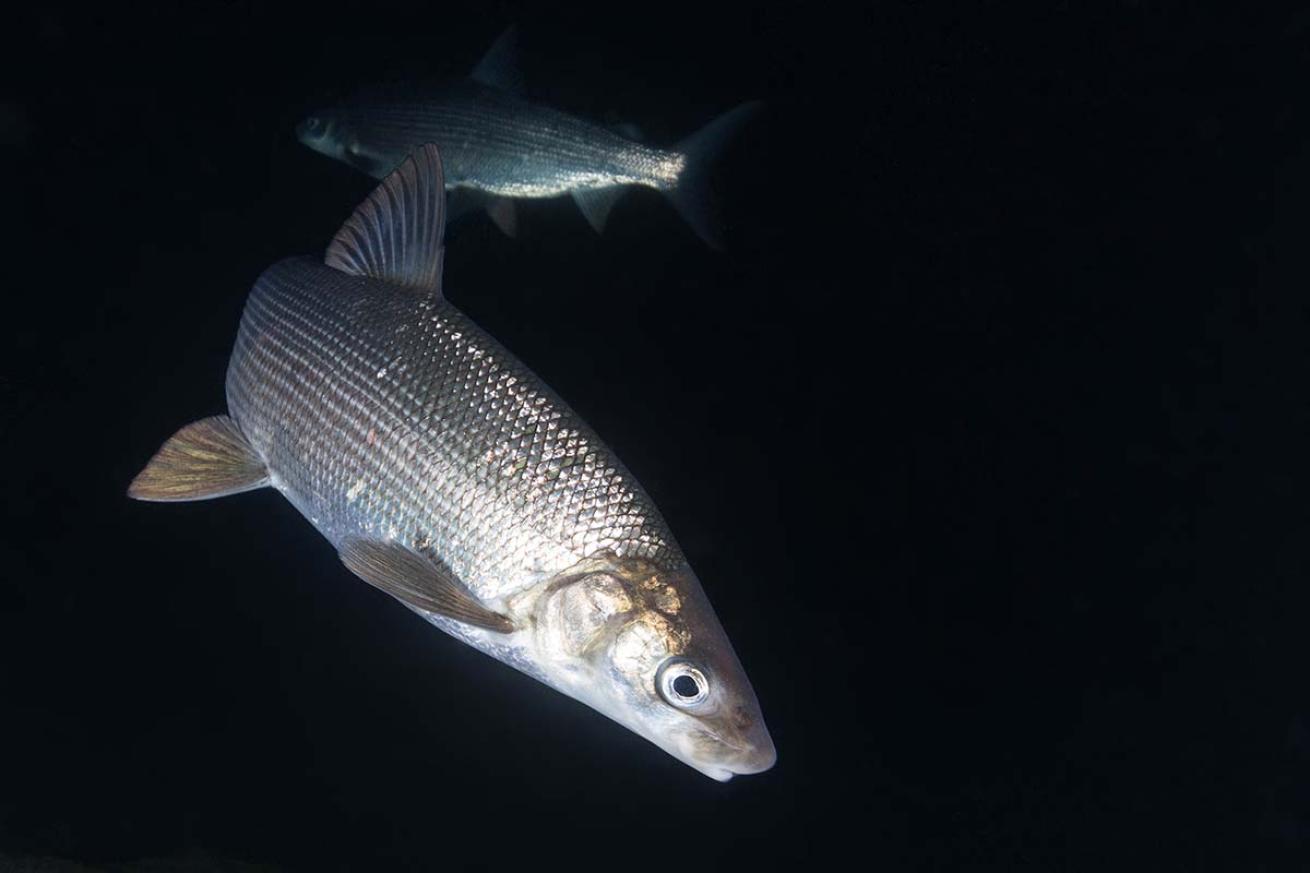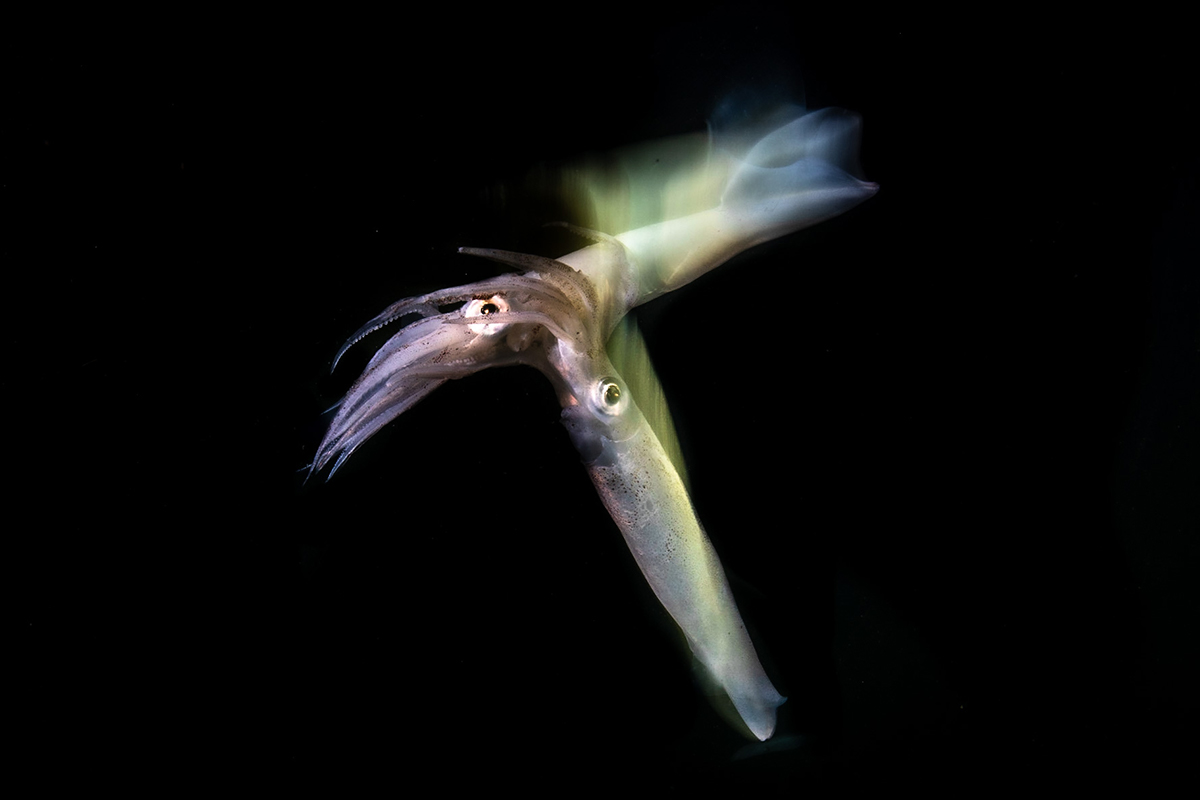Scuba Diving the Whitefish Spawning in Lake Superior

Alisha PostmaA fearless whitefish is entranced by the lens of a camera during their nighttime spawning event in the shallows of Silver Harbour Conservation Area, Lake Superior.
The glacial water surrounding me is pitch black. It’s the kind of disorientating black that makes you lose track of time and space. My fingers have lost their dexterity and an ice cream headache has overtaken my brain.
As an Ontario scuba diver, I’ve explored many of my province’s lakes, rivers, and quarries. Some places boast interesting age-old treasures while others have astounding visibility. But until last fall the underwater realm of Lake Superior has remained ever-illusive, when my husband Joey and I traveled several hours from our home in Northern Ontario to the western bank to dip our fins into the largest and clearest of the Great Lakes.
Snaking along the expanse of Lake Superior coastline on our way to the city of Thunder Bay, we enjoyed the spectacular show of summer becoming fall. Here a local dive club awaited us, preparing their annual whitefish spawning dive. This night dive is planned in conjunction with the first frost, which changes the lake’s temperature.
On the edges of Lake Superior, as the summertime water temperature drops, masses of whitefish move inshore to shallower water where they spawn in the shoals of rubble and gravel. These freshwater fish are found throughout much of Canada and in parts of the Northern US, including all of the Great Lakes. This valuable commercial fish that prefers colder, deeper bodies of water.
Joey and I braved the liquid ice on two different nights. We struck out on the first, spending more time familiarizing ourselves with the lake’s topography than whitefish. Though we kept our dive a shallow 15 feet, club members let us know after the dive this was too deep.
On the second dive a few days later, we hit the whitefish spawning jackpot. Entering at the conservation areas docks, we finned east through the water, left the confines of the harbour and hugged the rocky shoreline between five to seven feet. It didn’t take long at this shallower depth for our first whitefish sighting to occur. Out of the inky blackness a silver two-and-a-half-foot body cruised through our field of vision.
Settling on the sandy bottom with the rock shoreline to our left we watched and waited, extinguishing all but one faint dive light. Several seconds later more glittering bodies began to circle. One, two, ten, twenty… At one point I could count close to thirty whitefish dancing on the fringe of our fields of vision.
The swarms of whitefish looped around our kneeling place on the bottom weaving in and out of blackness. The brave ones surveilled us with curiosity and approached on their way to spawn at the rocky shores, but most scattered at the first hint of light. When I gazed towards the moonlite surface, they seemed content with passing near our exhaled stream of bubbles.
Whitefish approached the shallows from all angles. As they swam inshore, many would proceed to dip low into the sand and rock piles attempting to rub their bellies against the bottom. This was combined with the random puffs of milky white substance discharged by the males. It was a process that seemed to repeat itself hundreds if not thousands of times over the course of our dive.
In the midst of the tornado of flashing scales, it was hard to imagine that by the end of the week business would resume as usual on Superior's lakebed. I marveled at this magnificent feat of nature, which seemed to continue even as we decided it was time to exit the water.
I have done my fair share of cold water dives, but I will admit — by the end of this spawning event my hands and feet were numb to the point that it felt painful. It would take several large mugs of steaming hot chocolate following the dive, for Joey and I to get everything back to temperature. That said, I would gladly re-live the frozen limbs and brain freeze to experience it again.
Need to Know:
Licensed Operator: Thunder Country Diving
Dive Site: The Silver Harbour Conservation Area—one of numerous sites in the region that was explored for silver in the 1800—is a single dive site roughly twenty minutes from the outskirts of Thunder Bay. Divers can access the water via the boat ramp or docks and follow the shoreline towards the east. The aquascape varies from boulders and large chunks of rock in the harbour to plant life and finer sand after exiting the harbour.
Depth: This site starts in the sunkissed shallows of the harbour between five and 10 feet and tapers down deeper from there as you move away from shore. During the whitefish spawning divers will want to make sure they are very shallow, in four to five feet of water.
Conditions: Lake Superior is a wild lake that has been known to go from calm conditions to storm surges at the drop of a dime. The warmest water is in August when it reaches 65 degrees F and the coldest is in March at 32 degrees F. The average temperature of this lake throughout the year is 40 degrees F.
Lake Superior is easily the clearest of the Great Lakes. The average underwater visibility is 27 feet. Of course this very much depends on surface conditions. The visibility dramatically increases in the winter months.
Equipment: Lake Superior's water are the coldest of the Great Lakes therefore adequate thermal protection is strongly recommended. Divers should use a minimum of 7mm wetsuit, semi dry or drysuit (preferred) complete with booties, gloves and a hood. At the Silver Harbour Conservation Area divers should also carry a dive flag with them during the day as there is boat traffic.











